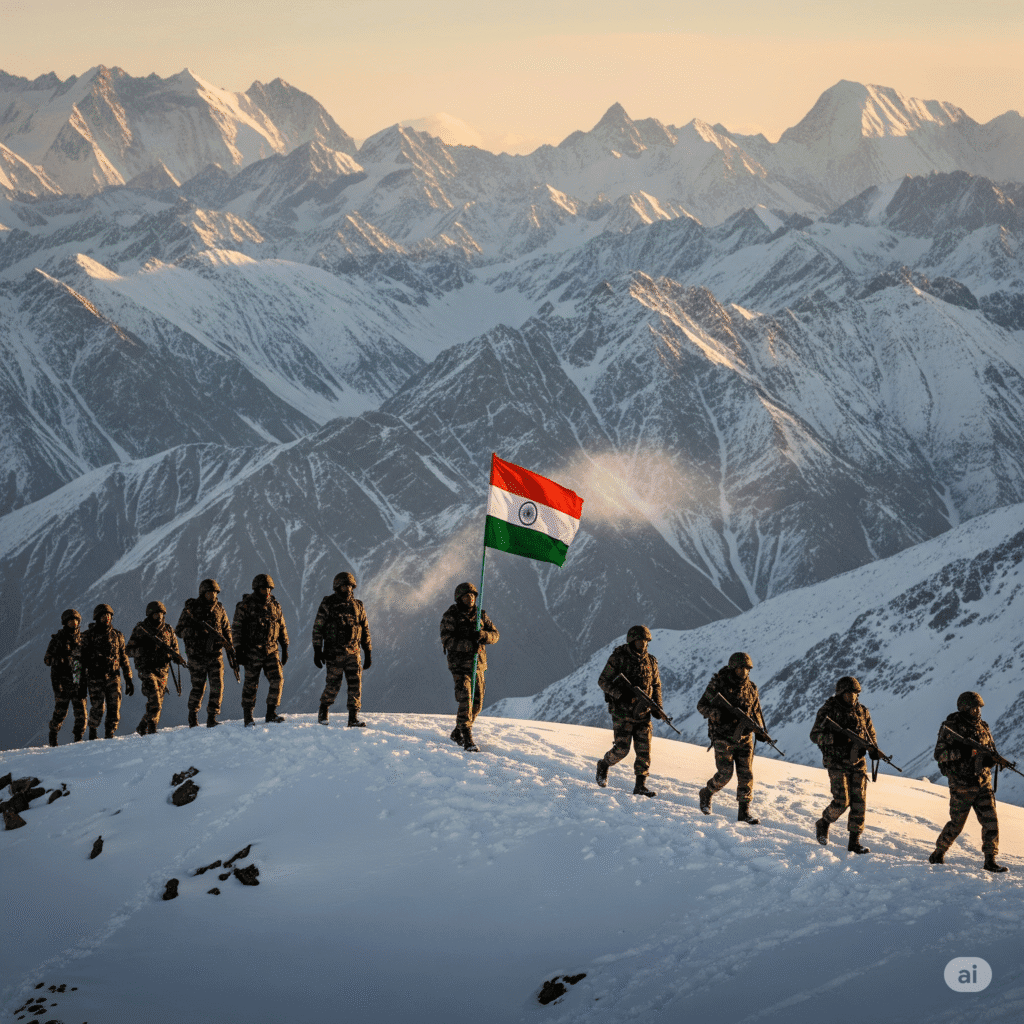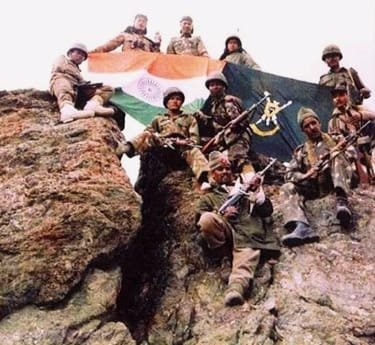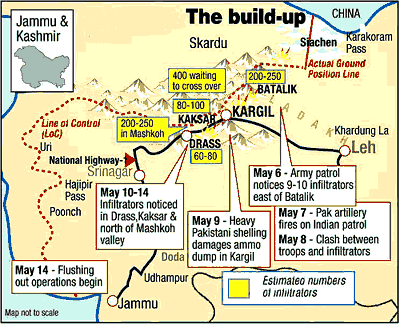The Kargil War, fought between May and July 1999, stands as a defining episode in the modern history of India and Pakistan. Set against the treacherous backdrop of the Himalayas in Jammu and Kashmir, the conflict erupted when Indian forces discovered that Pakistani troops—disguised as insurgents—had covertly infiltrated key Indian military positions in the Kargil sector. These posts, temporarily vacated by Indian soldiers during the harsh winter, became flashpoints for a high-altitude confrontation at altitudes ranging from 10,000 to 18,000 feet.
Codenamed Operation Vijay by the Indian Army and Operation Safed Sagar by the Indian Air Force, the two-month military campaign resulted in a decisive Indian victory. By July 1999, the intruders were pushed back across the Line of Control, thanks to India’s determined military response and growing international pressure on Pakistan to de-escalate.
What made the conflict particularly startling was its timing. Just a few months earlier, in February 1999, both nations had signed the Lahore Declaration, a landmark diplomatic initiative aimed at promoting peace and confidence-building between the two nuclear-armed neighbours. The Kargil intrusion shattered this fragile momentum, widely seen as a betrayal of trust. Prime Minister Atal Bihari Vajpayee, who had championed the peace process, voiced India’s profound disappointment over Pakistan’s actions.

Beyond the battlefield, the Kargil War had lasting implications. It was not only a rare instance of conventional warfare between nuclear-capable states but also a stark reminder of the volatility of the region. The war exposed significant gaps in India’s border surveillance and intelligence systems, prompting sweeping reforms in defense preparedness. For Pakistan, the outcome triggered political fallout and increased international isolation.
In retrospect, the Kargil conflict reshaped strategic thinking in South Asia. It remains a potent symbol of the delicate balance between diplomacy and defense in a region marked by historical animosity and nuclear tension.
The Kashmir Conflict: The Deeper Story Behind Kargil
The Kargil War didn’t happen in a vacuum. To really understand why it occurred, we need to go back—way back—to 1947, the year British India was divided into two nations: India and Pakistan. Caught in the middle of this historic partition was the princely state of Jammu and Kashmir—a region with a Muslim-majority population but ruled by a Hindu king, Maharaja Hari Singh.
At first, the Maharaja wanted to stay neutral—not joining either country. But everything changed in October 1947, when tribal fighters from Pakistan invaded Kashmir. Faced with this crisis, Hari Singh turned to India for help. In exchange for military support, he signed the Instrument of Accession, officially making Jammu and Kashmir a part of India. This triggered the First Indo-Pak War (1947–48), the start of a conflict that still shapes India-Pakistan relations today.
From Ceasefire to the Line of Control
That first war ended with a UN-brokered ceasefire in 1949, drawing a temporary border known as the Ceasefire Line. But the issue wasn’t resolved—far from it. The next few decades saw repeated wars and standoffs. After the 1971 war, both countries signed the Simla Agreement in 1972, turning the Ceasefire Line into the Line of Control (LoC)—a 740 km stretch of tense military boundary.
Under this agreement, India and Pakistan promised to respect the LoC and settle disputes through peaceful dialogue. But the Simla Agreement left one thing intentionally vague: the final status of Kashmir. This ambiguity turned the LoC into a symbol of unresolved tension—a line drawn not just on a map, but through the heart of Indo-Pak relations.
Infiltration, Insurgency, and the Road to Kargil
The decades following the Simla Agreement were marked by constant tension. In 1965, Pakistan tried to stir unrest in Kashmir by sending armed forces in disguise under Operation Gibraltar. This plan failed, but it revealed a new tactic: covert infiltration.
By the late 1980s, trouble in Kashmir was boiling over. In 1989, a violent insurgency erupted in Indian-administered Kashmir. Pakistan supported this movement by backing militants and cross-border attacks. These years were marked by proxy wars, bombings, and massive unrest. Despite both nations claiming to support peace, the border saw frequent violations—Kargil was just a larger, more visible flare-up of this ongoing cold conflict.
The Nuclear Shadow
A major twist came in the late 1990s. India tested nuclear weapons in 1974, but in May 1998, both India and Pakistan conducted official nuclear tests within weeks of each other. The world was alarmed—two bitter rivals now had nuclear capabilities.
Some thought this might prevent wars—after all, who would risk nuclear disaster? But the Kargil War proved otherwise. It showed that while nuclear weapons might prevent full-scale war, they didn’t stop smaller, high-risk military gambles.
Pakistan’s planners seemed to believe their nuclear arsenal would act as a shield, discouraging India from a strong retaliation. But India responded with measured force, keeping the fight within its side of the LoC and winning global support for its restraint. This careful strategy helped India both win the war militarily and diplomatically, positioning itself as a responsible power.
The result? The Kargil War became a real-world example of what’s called the “stability–instability paradox.” In short: when countries have nuclear weapons, it may reduce the risk of total war but increase the chances of smaller, dangerous conflicts under the nuclear umbrella.

A Silent Infiltration and India’s Swift Response
In the winter of 1998–99, while Indian Army posts in Kargil lay vacant due to extreme weather, Pakistani troops quietly crossed the Line of Control under a covert plan named Operation Badr. These soldiers, mainly from the Northern Light Infantry, were disguised as militants and occupied strategic heights with a bold aim: cut off National Highway 1A, India’s critical supply route to Ladakh and Siachen.
The plan stayed under wraps for weeks, masked by artillery fire and harsh terrain—until May 3, 1999, when a local shepherd spotted unusual movement. Within days, Indian patrols uncovered the scale of the intrusion, which stretched across multiple sectors and covered nearly 200 square kilometers.
In response, the Indian Army launched Operation Vijay on May 10, deploying nearly 30,000 troops to the conflict zone. Despite operating in some of the world’s toughest combat conditions, Indian forces began reclaiming lost ground—without crossing the LoC, a move intended to avoid international escalation.
To support the ground assault, the Indian Air Force launched Operation Safed Sagar on May 26, using Mirage 2000 jets to deliver precision strikes on enemy positions. Despite early setbacks, the air campaign proved vital in weakening supply lines and supporting troops on the frontlines.
Scaling the Heights: Courage Under Fire in Kargil
The Kargil War was unlike any other—a relentless battle for altitude, fought on some of the world’s highest and harshest peaks. The Indian Army faced a steep challenge: reclaim vital mountain posts overlooking the Srinagar-Leh highway, across the Dras, Batalik, and Mushkoh sectors. Each peak was more than just ground—it was a strategic lifeline, hard-won through grit, sacrifice, and sheer determination.
The Battle for Tololing: Grit at 16,000 Feet
Among the first major clashes was the fight for Tololing, a towering ridge in the Dras sector. Pakistani forces had captured it, giving them a commanding view of National Highway 1A. In late May 1999, Indian troops began a series of intense uphill assaults on this heavily fortified position.
Progress was slow and punishing. Harsh weather, steep slopes, and constant enemy fire made each advance deadly. Still, Indian forces pushed forward. Point 4590 was recaptured on June 13, turning the tide in this area. The success came at a heavy price, including the life of Major Rajesh Adhikari, who was posthumously awarded the Maha Vir Chakra for his bravery.
Tiger Hill: The Peak of Resolve
One of the most iconic battles of the war unfolded at Tiger Hill, standing at a formidable 16,500 feet. Pakistani forces were deeply entrenched, repelling repeated counterattacks. Yet the Indian Army launched a bold and sustained offensive, climbing icy cliffs under fire in freezing temperatures.
The name Captain Vikram Batra became forever linked with Tiger Hill. His iconic words, “Yeh Dil Maange More!”, captured the spirit of the Indian soldier in battle. Alongside him, Grenadier Yogendra Singh Yadav, despite multiple bullet wounds, scaled a vertical face and neutralized enemy bunkers, earning the Param Vir Chakra. The final assault on July 4, 1999, led by units like Lieutenant Balwan Singh’s Ghatak Platoon, marked a major operational breakthrough.
Point 4875: Where Heroes Fought and Fell
Another fierce clash occurred at Point 4875, which overlooked the Srinagar-Leh highway. Pakistani forces had dug in deep, posing a direct threat to supply lines. Indian troops launched a high-risk assault to retake the post.
Captain Vikram Batra, fresh from his victory at Point 5140, led from the front again—but was killed in action during the mission. His bravery became a lasting symbol of leadership and sacrifice. Captain Manoj Kumar Pandey, mortally wounded, continued to command until the objective was secured. Rifleman Sanjay Kumar, also severely injured, eliminated several enemy positions in hand-to-hand combat, earning the Param Vir Chakra for his courage.
“Captain Vikram Batra, over satellite radio, declared “Yeh Dil Maange More!”—a phrase he later explained meant pushing beyond expectations, giving everything to the mission and team.
Diplomacy Under the Nuclear Shadow
While soldiers fought bitter battles in the heights of Kargil, another critical front was unfolding on the global stage. For the first time, a conflict between India and Pakistan was taking place under the looming presence of nuclear weapons, grabbing immediate international attention.
India’s Strategic Restraint Pays Off
India’s decision to limit its military operations strictly to its side of the Line of Control (LoC) became a significant factor in shaping global perception. By showing restraint despite provocation, India positioned itself as a responsible actor, in contrast to Pakistan’s initial denials and veiled nuclear posturing.
Global Sentiment Turns Against Pakistan
The world closely followed the conflict, and Pakistan’s infiltration across the LoC was widely viewed as an act of aggression. Though many nations avoided naming names directly, their messages were clear. At the G8 Summit in Cologne (June 1999), leaders emphasized that military actions must not alter the LOC. The European Union echoed similar concerns, calling for a return to dialogue and respect for agreements like the Lahore Declaration.
Even China, traditionally seen as Pakistan’s ally, refrained from offering full support. During a key visit by General Pervez Musharraf to Beijing, Chinese leaders reportedly advised restraint and discouraged further escalation. Russia and Israel, meanwhile, voiced open support for India, backing the sanctity of the LoC and rejecting any external mediation.
The United States Steps In
The United States played a crucial behind-the-scenes role throughout the conflict. The Clinton administration, breaking from its earlier neutral approach to South Asia, strongly backed India’s position. The incursions were deemed illegitimate, and the U.S. emphasized that the LoC must be respected.
The diplomatic spotlight intensified on July 4, 1999, when Pakistani Prime Minister Nawaz Sharif met President Bill Clinton in Washington. Despite Sharif’s request for U.S. intervention, Clinton refused to mediate. Instead, the joint statement released after the meeting stressed Pakistan’s need to withdraw and reaffirmed the inviolability of the LoC.
It’s also believed that U.S. intelligence provided India with intercepted communications between Pakistani military officials, which served as hard proof of Pakistan’s direct involvement. These revelations further tilted global opinion and built diplomatic pressure on Pakistan to disengage.

The Aftermath and Lasting Impact
With the final positions cleared and troops withdrawn, India declared the success of Operation Vijay on July 26, 1999—a date now marked annually as Kargil Vijay Diwas. While the military objective had been met, the consequences of the conflict rippled far beyond the battlefield.
A Costly Victory
India’s territorial integrity was restored, but the human toll was significant. The country lost 527 soldiers, with more than 1,360 wounded, alongside the downing of three aircraft. Pakistan’s casualty figures, on the other hand, remain disputed—official figures were never released, but estimates range from several hundred to over four thousand. The lack of clarity reflects the secrecy surrounding their losses.
Political Shockwaves in Pakistan
The Kargil War episode triggered deep internal turmoil in Pakistan. Prime Minister Nawaz Sharif’s decision to withdraw under global pressure was seen as a political failure, especially by the military leadership. Tensions escalated, and within months, General Pervez Musharraf—widely viewed as the architect of the Kargil plan—led a military coup in October 1999. Civilian authority was sidelined, and Pakistan entered another prolonged phase of military rule.
The War’s Civilian Toll
The fighting displaced thousands of civilians on both sides of the LoC. Indian residents gradually returned, but many Pakistani civilians remained displaced for years, caught in the shadow of a war they didn’t start. For families of soldiers, the emotional scars ran deep—loss, trauma, and a lasting sense of sacrifice. The psychological burden on frontline troops, who faced extreme cold, thin air, and constant danger, became an enduring part of the war’s legacy.
India’s Military Reforms in Motion
Kargil exposed serious gaps in intelligence, surveillance, and coordination. To address this, India launched a wave of defense reforms based on recommendations by the Kargil Review Committee (KRC):
- Intelligence Revamp: New agencies like the Defence Intelligence Agency (DIA) and National Technical Research Organisation (NTRO) were formed. Satellite imaging, thermal sensors, and UAVs were brought in to monitor borders more effectively.
- Tri-Service Integration: The need for better coordination between the Army, Navy, and Air Force led to the creation of the Integrated Defence Staff (IDS) and, later, the appointment of the Chief of Defence Staff (CDS) in 2019.
- Modern Equipment & Training: The Army improved high-altitude warfare capabilities through the High-Altitude Warfare School (HAWS) and inducted modern gear—including better rifles, night-vision devices, and lightweight artillery like M777 howitzers and K9 Vajra systems. The Air Force also upgraded with Rafale jets, Mirage 2000 upgrades, S-400 systems, and the development of indigenous Light Combat Helicopters (LCHs).
Shifting Ground in India–Pakistan Relations
Kargil reshaped the already fragile relationship between the two nations:
- Trust Eroded: The timing of the conflict—just after the Lahore peace talks—left India deeply distrustful of future diplomatic engagements.
- Border Vigilance Intensified: India expanded troop presence along the LoC and upgraded monitoring infrastructure.
- Public Exchange Diminished: Civilian and cultural exchanges suffered, deepening the divide between people across the border.
- Global Standing Altered: While India gained diplomatic ground, Pakistan faced growing isolation, especially with its covert role in the conflict laid bare.
- Nuclear Deterrence Questioned: The war challenged assumptions around nuclear deterrence. It exposed a troubling paradox: strategic stability at the nuclear level didn’t prevent conventional aggression, but rather encouraged limited conflict under the belief that escalation would be avoided.
Looking Back: Kargil and the Questions That Remain
More than two decades have passed since the Kargil War, but its legacy continues to shape how India and Pakistan view each other, and how both prepare for future threats. What began as a covert intrusion turned into a full-fledged military confrontation that tested strategy, stamina, and diplomacy—all under the shadow of nuclear arms.
The conflict highlighted just how quickly peace can unravel, even after high-level diplomacy like the Lahore Declaration. It exposed the vulnerabilities in border surveillance, brought global attention to the fragility of South Asia’s security balance, and served as a wake-up call for both nations to rethink their military and diplomatic strategies.
For India, Kargil became more than a military win. It was a lesson in preparedness, unity, and strategic patience. The restraint shown during the conflict earned international respect, while the soldiers’ courage under unimaginable conditions etched their names into history.
Kargil also left lingering questions: Can diplomacy truly hold in a region with such deep-rooted tensions? How does one prevent future flare-ups in a nuclear-armed environment? And what role should global powers play in ensuring that conflicts like Kargil don’t escalate into something far worse?
As we continue to mark Kargil Vijay Diwas, these questions remain just as relevant today. Remembering the war isn’t just about honoring bravery—it’s about understanding the complexities of conflict and the cost of unresolved disputes.
🕊️ Honour the valour. Learn from history.
📢 Share this piece to keep the legacy of Kargil alive
🌐 Discover more thought-driven content at thinkingthorough.com
💬 Your voice matters—join the dialogue with us on social platforms
References
Examine the evolution of the Line of Control (LOC) between India and Pakistan. What are the key issues associated with the LOC, and what measures have been undertaken to manage tensions along this frontier? (15 marks, 250 words) – PWOnlyIAS. (n.d.). PWOnlyIAS. https://pwonlyias.com/mains-answer-writing/examine-the-evolution-of-the-loc-between-india-and-pakistan/
India, T. O. (2025, May 8). Kashmir to Kargil: Timeline of Indo-Pak conflicts since independence. The Times of India. https://timesofindia.indiatimes.com/india/kashmir-to-kargil-timeline-of-indo-pak-conflicts-since-independence/articleshow/120962294.cms
Kargil War Heroes: Soldiers name List, photos, diwas, and Memorial. (n.d.). Testbook. https://testbook.com/static-gk/kargil-war-heroes
PIB Headquarters. (n.d.). https://www.pib.gov.in/PressNoteDetails.aspx?NoteId=154940&ModuleId=3
Wikipedia contributors. (2025, July 8). Kargil war. Wikipedia. https://en.wikipedia.org/wiki/Kargil_War
Image 1 Credit: By Indian Army – http://indianarmy.nic.in/FlashImage/F15.jpg Archive, GODL-India, https://commons.wikimedia.org/w/index.php?curid=47048948
Image 2 Credit: By Stbalbach at English Wikipedia http://www.ccc.nps.navy.mil/research/kargil/index.asp, Public Domain, https://commons.wikimedia.org/w/index.php?curid=11877668
Frequently Asked Questions (FAQs) about Kargil War
What caused the Kargil War?
The war began after Pakistani soldiers and militants infiltrated Indian positions in the Kargil region.
How many soldiers died in the Kargil War?
Around 527 Indian soldiers and over 700 Pakistani soldiers lost their lives.
